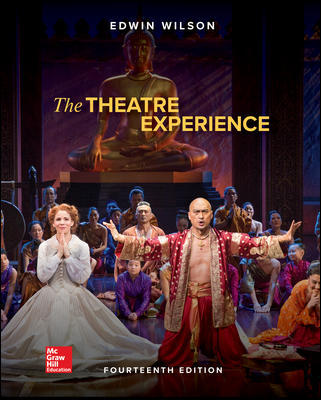Description
Test Bank For The Theatre Experience 14Th Edition By Edwin Wilson
Part 1: The Audience
Chapter 1: The Audience: Its Role and Imagination
Chapter 2: Background and Expectations of the Audience
Chapter 3: Theatre Spaces
Part 2: The Performers and the Director
Chapter 4: Acting for the Stage
Chapter 5: The Director and the Producer
Part 3: The Playwright and the Play
Chapter 6: Creating the World of the Play
Chapter 7: Dramatic Structure and Dramatic Characters
Chapter 8: Theatrical Genres
Part 4: The Designers
Chapter 9: Scenery
Chapter 10: Stage Costumes
Chapter 11: Lighting and Sound
Part 5: The Theatre Today
Chapter 12: The Theatre Today: Traditional, Musical, Nontraditional, and Political Theatre
Chapter 13: Global Theatre Today: Diverse and Global
Plays That May Be Read Online
The Theatre Experience, 14e (Wilson)
Chapter 2 The Background and Expectations of the Audience
1) A question that is NOT one of the criteria by which to judge a play and a production is
A) “What is being attempted?”
B) “Have the intentions been achieved?”
C) “Were the intentions appreciated by the audience?”
D) “Was the attempt worthwhile?”
Answer: C
Bloom’s: Remember
Accessibility: Keyboard Navigation
LO: List the three criteria for criticism
2) A critic might offer background information about the
A) playwright.
B) subject matter of the play.
C) style of the production.
D) All of these answers are correct.
Answer: D
Bloom’s: Remember
Accessibility: Keyboard Navigation
LO: Describe the use of facts when reading commentary by a critic/reviewer
3) A critic usually has more ________ than a reviewer.
A) time
B) space
C) knowledge
D) All of these answers are correct.
Answer: D
Bloom’s: Remember
Accessibility: Keyboard Navigation
LO: Identify the characteristics of a critic
4) Which of the following usually works for a television station, a newspaper, or a magazine and reports on what has occurred at the theatre?
A) reviewer
B) critic
C) both reviewer and critic
D) neither reviewer nor critic
Answer: A
Bloom’s: Remember
Accessibility: Keyboard Navigation
LO: Identify the characteristics of a critic
5) Which of the following attempts to go into greater detail in describing or analyzing a theatre event?
A) reviewer
B) critic
C) both reviewer and critic
D) neither reviewer nor critic
Answer: B
Bloom’s: Remember
Accessibility: Keyboard Navigation
LO: Identify the characteristics of a critic
6) Which of the following will often try to explain how the theatre event fits into a category or genre, or into the body of the playwright’s work?
A) reviewer
B) critic
C) both reviewer and critic
D) neither reviewer nor critic
Answer: B
Bloom’s: Remember
Accessibility: Keyboard Navigation
LO: Describe the use of facts when reading commentary by a critic/reviewer
7) Which of the following is usually restricted by time, space, or both?
A) reviewer
B) critic
C) both reviewer and critic
D) neither reviewer nor critic
Answer: A
Bloom’s: Remember
Accessibility: Keyboard Navigation
LO: Identify the characteristics of a critic
8) Which of the following is frequently limited in terms of experience and theatrical background?
A) reviewer
B) critic
C) both reviewer and critic
D) neither reviewer nor critic
Answer: A
Bloom’s: Remember
Accessibility: Keyboard Navigation
LO: Identify the characteristics of a critic
9) Which of the following attempts to analyze a theatre event very closely?
A) reviewer
B) critic
C) both reviewer and critic
D) neither reviewer nor critic
Answer: B
Bloom’s: Remember
Accessibility: Keyboard Navigation
LO: Describe the use of facts when reading commentary by a critic/reviewer
10) Which of the following might offer an opinion about whether or not the event is worth seeing?
A) reviewer
B) critic
C) both reviewer and critic
D) neither reviewer nor critic
Answer: C
Bloom’s: Remember
Accessibility: Keyboard Navigation
LO: Identify the characteristics of a critic
11) Which of the following attempts to put the theatre event into a larger context?
A) reviewer
B) critic
C) both reviewer and critic
D) neither reviewer nor critic
Answer: B
Bloom’s: Understand
Accessibility: Keyboard Navigation
LO: Describe the use of facts when reading commentary by a critic/reviewer
12) Which of the following is NOT a responsibility of a dramaturg?
A) researching criticism of past productions of plays their theatre is doing
B) writing research notes or small articles most often used in the programs for the audience’s benefit
C) production research to determine the style of the play that the director will employ
D) identifying older yet meaningful plays that may have been overlooked in planning a theatre season
Answer: C
Bloom’s: Remember
Accessibility: Keyboard Navigation
LO: Recall the responsibilities of a dramaturg
13) Because a “collective mind” is created when a large number of people are gathered into a group, the background of the individual spectator has little to do with the theatre experience.
Answer: FALSE
Bloom’s: Remember
Accessibility: Keyboard Navigation
LO: Demonstrate that individual audience backgrounds contribute to our viewing experience
14) Women comprised the largest part of the audience in ancient Greece.
Answer: FALSE
Bloom’s: Remember
Accessibility: Keyboard Navigation
LO: Describe the relationship between theatre and society
15) Because artists are often accused of being “antisocial,” “subversive,” or “enemies of the state,” and are thus outsiders, the art that they produce is often unrelated to the society in which it is produced.
Answer: FALSE
Bloom’s: Remember
Accessibility: Keyboard Navigation
LO: Describe the relationship between theatre and society




Be the first to review “Test Bank For The Theatre Experience 14Th Edition By Edwin Wilson”